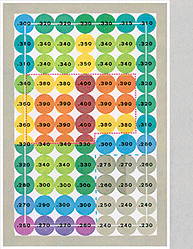An article in the 12/17/2001 issue of InfoWorld makes passing reference to the baseball strike zone area--1%--that will yield a solidly hit ball. I got curious and did my own analysis. First, I calculated the frontal area of the bat based on bat size and the percentage of the bat that can actually make solid contact. This gives me what I'll call Bat Contact Area (BCA).
Then, I calculated the frontal area of the strike zone. I ignored the fact that (a) curving pitches increase the effective width of the strike zone and (b) umpires don't call the strike zone anyway. This gives me what I'll call the Strike Zone Cross-Section (SZCS).
I then arrive at what I call the Static Bat Area Coverage (SBAC) by dividing the BCA by the SZCS: 4.2%. Next, I factor in the timing issue. I assume that bat speed is always 70 mph. I'll assume that the ball can be hit anywhere while over the plate. I calculate that the bat is somewhere over the plate for 0.014 seconds: Bat Traverse Time (BTT).
I then assume that the fastest pitch is 95 mph and that the slowest pitch is 55 mph. This means that the fast pitch arrives 0.434 seconds after the pitcher releases it, versus 0.750 seconds for the slow pitch. The delta is 0.316 seconds: the Pitch Arrival Variability (PAV). I next come to the Dynamic Bat Time Coverage (DBTC) by dividing the BTT by the PAV. I get 4.4%, curiously close to the SBAC figure of 4.2%, above. The final answer, then, is expressed as the product of SBAC and DBTC: 4.2% x 4.4% = 0.19%. In other words, only 0.2% of the strike zone yields a solidly struck ball. Not far off of the author's back of the envelope calculation. A famous graphic put together by Ted Williams says it far better than I have (click image for more). 
|
